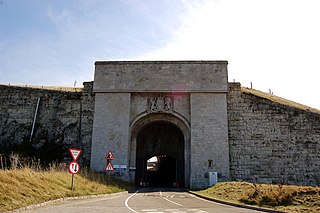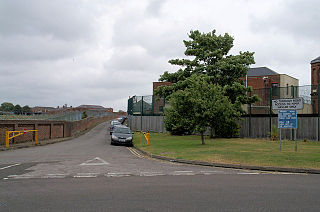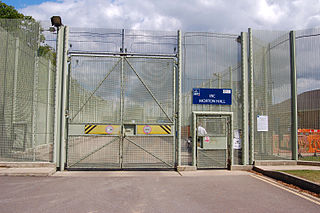
The Woomera Immigration Reception and Processing Centre (IRPC) was an Australian immigration detention facility near the village of Woomera in South Australia. It was opened in November 1999 in response to an increase in unauthorised arrivals, which had exceeded the capacity of other detention facilities. It was originally intended to hold 400 people, however at its peak in April 2000 it had nearly 1,500 detainees. After ongoing public pressure in response to several well publicised riots from 2000, accusations of human rights abuses, and capacity issues, the centre closed in April 2003.

Villawood Immigration Detention Centre, originally Villawood Migrant Hostel or Villawood Migrant Centre, split into a separate section named Westbridge Migrant Hostel from 1968 to 1984, is an Australian immigration detention facility located in the suburb of Villawood in Sydney, Australia.

The Nauru Regional Processing Centre is an offshore Australian immigration detention facility in use from 2001 to 2008, from 2012 to 2019, and from September 2021. It is located on the South Pacific island nation of Nauru and run by the Government of Nauru. The use of immigration detention facilities is part of a policy of mandatory detention in Australia.
Immigration detention is the policy of holding individuals suspected of visa violations, illegal entry or unauthorized arrival, as well as those subject to deportation and removal until a decision is made by immigration authorities to grant a visa and release them into the community, or to repatriate them to their country of departure. Mandatory detention refers to the practice of compulsorily detaining or imprisoning people seeking political asylum, or who are considered to be illegal immigrants or unauthorized arrivals into a country. Some countries have set a maximum period of detention, while others permit indefinite detention.

HM Prison The Verne is a Category C men's prison located within the historic Verne Citadel on the Isle of Portland in Dorset, England. Operated by His Majesty's Prison Service, HMP The Verne was established in 1949 and occupies the southern part of the citadel. After a brief spell as an Immigration Removal Centre in 2014–2017, HMP The Verne re-opened in 2018.
Independent monitoring boards (IMB) are statutory bodies established by the Prison Act 1952 to monitor the welfare of prisoners in the UK to ensure that they are properly cared for within Prison and Immigration Centre rules, whilst in custody and detention. Their responsibilities were extended to Immigration Removal Centres by the Immigration and Asylum Act 1999 following an inspection in 1989 of what was then Harmondsworth Detention Centre.

Dungavel Immigration Removal Centre is an immigration detention facility in South Lanarkshire, Scotland, near the town of Strathaven that is also known as Dungavel Castle or Dungavel House. It is operated by Mitie Care and Custody, under contract with the law-enforcement command Immigration Enforcement for its detention of immigrants for the Home Office. It is the only such facility in Scotland.

Yarl's Wood Immigration Removal Centre is a detention centre for foreign nationals prior to their deportation from the United Kingdom, one of 10 such centres currently in the UK. It is located near Milton Ernest in Bedfordshire, England, and is operated by Serco, which describes the place as "a fully contained residential centre housing adult women and adult family groups awaiting immigration clearance." Its population is, and has been, overwhelmingly female.
Harmondsworth Immigration Removal Centre is an immigration detention facility in Harmondsworth, London Borough of Hillingdon, near London Heathrow Airport run by Mitie. Harmondsworth, which neighbours the Colnbrook Immigration Removal Centre, holds around 620 men.
Colnbrook Immigration Removal Centre is located in Harmondsworth, London Borough of Hillingdon. Colnbrook, adjacent to Harmondsworth Immigration Removal Centre and London Heathrow Airport, houses only males. Colnbrook, which opened in August 2004, is built to Class B prison standards, making it one of the highest security immigration removal centres in the United Kingdom alongside Brook House. Colnbrook has 308 bed spaces.
The Australian government has a policy and practice of detaining in immigration detention facilities non-citizens not holding a valid visa, suspected of visa violations, illegal entry or unauthorised arrival, and those subject to deportation and removal in immigration detention until a decision is made by the immigration authorities to grant a visa and release them into the community, or to repatriate them to their country of origin/passport. Persons in immigration detention may at any time opt to voluntarily leave Australia for their country of origin, or they may be deported or given a bridging or temporary visa. In 1992, Australia adopted a mandatory detention policy obliging the government to detain all persons entering or being in the country without a valid visa, while their claim to remain in Australia is processed and security and health checks undertaken. Also, at the same time, the law was changed to permit indefinite detention, from the previous limit of 273 days. The policy was instituted by the Keating government in 1992, and was varied by the subsequent Howard, Rudd, Gillard, Abbott, Turnbull, Morrison and Albanese Governments. The policy is regarded as controversial and has been criticised by a number of organisations. In 2004, the High Court of Australia confirmed the constitutionality of indefinite mandatory detention of non-citizens. However, this interpretation was overturned in a landmark decision in 2023, with the High Court concluding the practice was unlawful and unconstitutional.
Dover Immigration Removal Centre was an immigration detention centre, located in the historic citadel of the Western Heights fortifications in Dover, England. The centre was operated by Her Majesty's Prison Service, and formally closed in November 2015. Dover has been designated as an historic site by English Heritage.

Haslar Immigration Removal Centre was an immigration detention centre, located in Haslar, Hampshire, England. The centre was operated by Her Majesty's Prison Service. The centre closed in 2016 with the Ministry of Justice planning to retain the site for use as a prison – plans which were later scrapped. In September 2022, the Guardian reported that Haslar immigration removal centre would reopen in late 2023.

HM Prison Morton Hall is a Category C men's prison, located in the village of Morton Hall in Lincolnshire, England. The centre is operated by His Majesty's Prison Service. It was previously a women's prison and from 2011 to 2021 it was an Immigration Removal Centre.

Christmas Island Immigration Reception and Processing Centre or commonly just Christmas Island Immigration Detention Centre, is an Australian immigration detention facility located on Christmas Island in the Indian Ocean.

The United States government holds tens of thousands of immigrants in detention under the control of Customs and Border Protection and the Immigration and Customs Enforcement (ICE). Immigrants are detained for unlawful entry to the United States, when their claims for asylum are received, and in the process of deportation and removal from the country. During Fiscal Year 2018, 396,448 people were booked into ICE custody: 242,778 of whom were detained by CBP and 153,670 by ICE's own enforcement operations. A daily average of 42,188 immigrants were held by ICE in that year. In addition, over twelve thousand immigrant children are housed by facilities under the supervision of the Office of Refugee Resettlement's program for Unaccompanied Alien Children. Prior to referral to these other agencies, the CBP holds immigrants at processing centers; between mid-May and mid-June 2019, it held between 14,000 and 18,000 immigrants.

Group 4 was a security business operating primarily in the United Kingdom and latterly worldwide.
The Saharonim Prison is an Israeli detention facility for African asylum seekers located in the Negev desert. It is the largest of a planned four camps with its total capacity of 8,000 inmates. Together with the Ktzi'ot prison, Sadot prison and the Nachal Raviv tent camp they detain South Sudanese, Sudanese and Eritrean asylum seekers who crossed the border from Egypt to Israel.
Immigration detention in the United Kingdom is the practice of detaining foreign nationals for the purpose of immigration control. Unlike some other countries, UK provisions to detain are not outlined in a codified constitution. Instead, immigration enforcement holds individuals under Powers granted in the Immigration Act 1971 and by the Home Office Detention Centre Rules (2001). The expressed purpose of immigration detention is to "effect removal; initially to establish a person's identity or basis of claim; or [implement] where there is reason to believe that the person will fail to comply with any conditions attached to a grant of immigration bail." Detention can only lawfully be exercised under these provisions where there is a "realistic prospect of removal within a reasonable period".
Tinsley House is a United Kingdom Immigration Removal Centre (IRC), where individuals are held while awaiting decisions on their asylum claim or considered for deportation from the UK for various reasons. It is located on Perimeter Road South of Gatwick Airport in Gatwick, West Sussex, England. Tinsley House is managed by security firm Serco on behalf of Border Force. When Tinsley House was established in 1996, it was the UK's first purpose-built detention centre. Since then, the UK's detention estate has expanded substantially and there are now nine immigration removal centres. Some individuals are also detained in short-term holding facilities and prisons.











